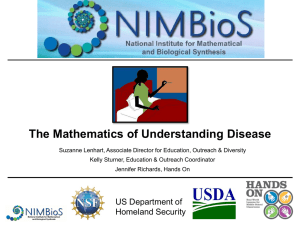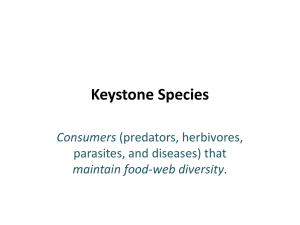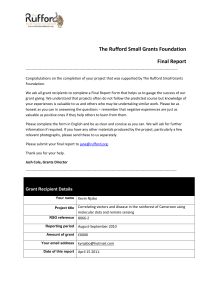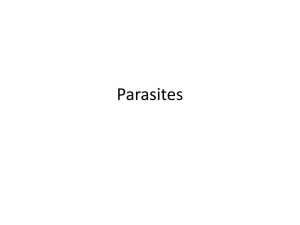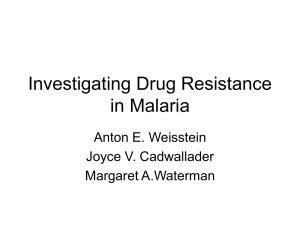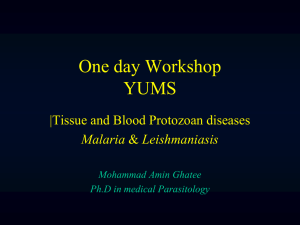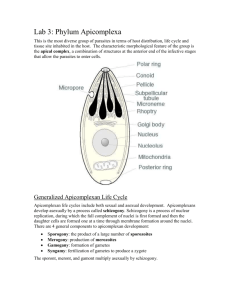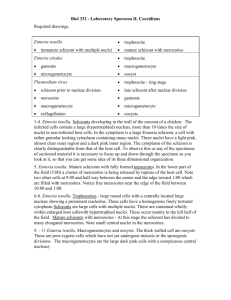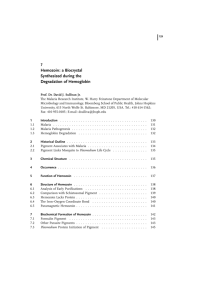Plasmodium
advertisement
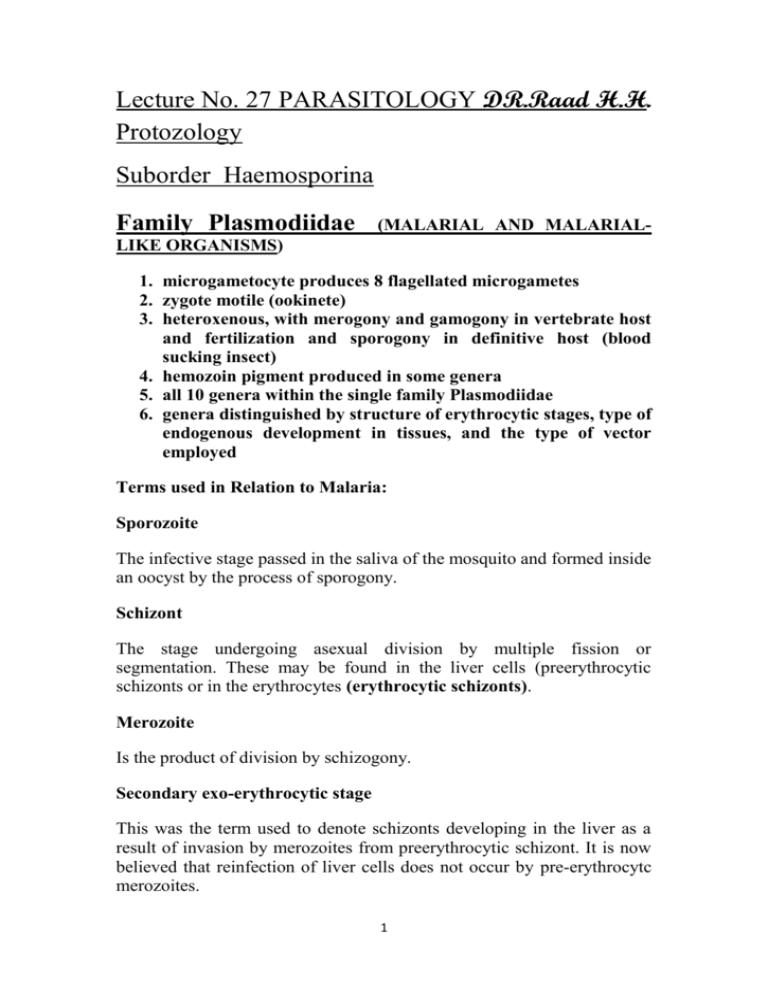
Lecture No. 27 PARASITOLOGY DR.Raad H.H. Protozology Suborder Haemosporina Family Plasmodiidae (MALARIAL AND MALARIAL- LIKE ORGANISMS) 1. microgametocyte produces 8 flagellated microgametes 2. zygote motile (ookinete) 3. heteroxenous, with merogony and gamogony in vertebrate host and fertilization and sporogony in definitive host (blood sucking insect) 4. hemozoin pigment produced in some genera 5. all 10 genera within the single family Plasmodiidae 6. genera distinguished by structure of erythrocytic stages, type of endogenous development in tissues, and the type of vector employed Terms used in Relation to Malaria: Sporozoite The infective stage passed in the saliva of the mosquito and formed inside an oocyst by the process of sporogony. Schizont The stage undergoing asexual division by multiple fission or segmentation. These may be found in the liver cells (preerythrocytic schizonts or in the erythrocytes (erythrocytic schizonts). Merozoite Is the product of division by schizogony. Secondary exo-erythrocytic stage This was the term used to denote schizonts developing in the liver as a result of invasion by merozoites from preerythrocytic schizont. It is now believed that reinfection of liver cells does not occur by pre-erythrocytc merozoites. 1 Trophozoite Is the stage of the asexual form with an undivided nucleus, seen in the erythrocyte. Microgametocyte The male gametocyte which produces a number of microgametes. Exflagellation The process by which microgametes are formed frm a microgametocyte. Macrogametocyte The female gametocyte which produces a single macrogamete. Zygote The fertilized ovum. Ookinete The motile stage of the zygote preceding the oocyst stage. Oocyst The zygote after the formation of the cyst wall. Sporogony The sexual phase in the life cycle of certain protozoa. In Plasmodia this takes place in the mosquito vector. Schuffner’s dots Pinkish small and round stippling seen on P. vivax and P. ovale infected red cells, in Romanowsky stained films. They appear earlier and in greater numbers in P. ovale than in P. vivax. Maurer’s dots Coarse and irregular stippling seen on P. falciparum infected red cells in Romanowsky stained films. 2 Ziemann’s dots Pinkish small dots sometimes seen in P. malariae infected red cells in Romanowsky stained films. Incubation period The interval between the entry of sporozoites and the first clinical manifestation. Pre-patent period The minimum time between the entry of sporozoites and the first appearance of parasites in red cells. Latency The duration between the primary attack of malaria and the relapse. There are no parasites in the circulation during this period. Paroxyses Bouts of fever due to the liberation of merozoites during the erythrocytic schizogony. Recrudescence Renewed manifestation of infection due to the survival of erythrocytic forms. Relapse(Recurrence) Renewed manifestation of infection due to the invasion of blood by merozoites from the late pre-erythrocytic stage (previously known as secondary exo-erythrocytic stage). Re-infection Renewed manifestation of infection not due to the original infection but resulting from subsequent fresh infection. Malaria : A mosquito-borne disease of humans , birds and other animals resulting from infection of the parenchynal cells of the liver and the red blood cells by apicomplexan parasites belonging to the genus Plasmodium. 3 Genus PLASMODIUM Characters : 1. 2. 3. 4. 5. 6. gamonts in erythrocytes merogony in erythrocytes and in other tissues hemozoin present vectors mosquitos or sandflies vertebrate hosts include mammals, birds, reptiles about 180 named species Classification 1. Plasmodium spp. are placed in phylum Apicomplexa 2. Both schizogony and gamogony occur in the life cycle 3. Sporozoites and merozoites have apical complexes 4. Species o a. Plasmodium vivax - benign tertian malaria o b. P. ovale - benign tertian malaria o c. P. malariae - benign quartan malaria o d. P. falciparum - malignant tertian malaria o e. Plasmodium gallinaceum (avian malaria), o f. Plasmodium reichenowi, a chimpanzee malaria Avian Malaria: Plasmodium gallinaceum reproduces in red blood cells. If the parasite load is sufficiently high, the bird begins losing red blood cells, causing anemia .Because red blood cells are critical for moving oxygen about the body, loss of these cells can lead to progressive weakness and, eventually, death .Malaria mainly affects birds in the order Passeriformes (perching birds). 4 Genus Haemoproteus Characters: 1. gamonts in erythrocytes 2. merogony in endothelial cells of blood vessels, especially in lungs; no erythrocytic merogony 3. hemozoin produced 4. vectors hippoboscid flies, gnats, and tabanids 5. vertebrate hosts birds, reptiles, and amphibia 6. about 160 named species Pathogenesis and Pathology Infections with most Haemoproteus spp. do not result in significant clinical signs. Experimental infection of turkeys with H. meleagridis resulted in lameness, diarrhea, depression, emaciation, anorexia and occasionally anemia. Muscovey ducks infected with H. nettionis suffered lameness, dyspnea and sudden death. Pigeons infected with H. columbae had enlarged gizzards. In other avian species, anemia, anorexia, and depression have been reported occasionally, but Haemoproteus generally is considered non5 pathogenic in most avian species. Post-mortem findings of infected birds include enlargement of the spleen, liver, and kidneys. These organs also may appear chocolate-brown due to hemozoin deposition. Cytologic imprints of these organs may reveal schizontladen endothelial cells. Some species of Haemoproteus will also form large, cyst-like bodies within skeletal muscles that resemble those seen with Sarcocystis spp. infections.4 Diagnosis 1. Diagnosis of Haemoproteus infection is generally accomplished by the microscopic examination of a Wrightor Giemsa-stained peripheral blood smear. Organisms may appear similar to Plasmodium, but the pigment within the intraerythrocytic gametocytes is more dispersed. The gametocytes partially encircle the erythrocyte nucleus forming a “halter-shaped” appearance. Haemoproteus gametocytes often occupy over one-half of the erythrocyte cytoplasm with little displacement of the host cell nucleus (Fig. 2). 2. In Plasmodium spp. infections (avian malaria), merozoites or ring forms of the organism are usually more apparent within erythrocytes . The rings may be single or multiple. Microrgametocytes and macrogametocytes also form within erythrocytes in Plasmodium infections but are observed infrequently. Both Haemoproteus and Plasmodium produce an insoluble pigment called hemozoin. This pigment is derived from the digestion of hemoglobin found within the host’s erythrocytes and appears as refractile, yellow to brown granules within the host’s erythrocyte. Treatment and Prevention Antimalarial drugs such as chloroquine may be useful in treating Haemoproteus sp. infection; however, medication generally is not recommended parasitic infection usually is nonpathogenic. Transmission of Haemoproteus sp. to susceptible birds may be minimized by reducing or eliminating the vector population. This is often achieved by habitat management to decrease vector breeding sites and by killing these insects with judicious application of pesticides that affect larval or adult stages. Screening of aviaries may be partially effective in eliminating some vectors such as mosquitoes, but routine screen mesh size may not reliably exclude culicoides species (biting midges) because of their small size (2 mm). Exclusion of biting midges 6 requires a screen mesh size < #16, but this fine mesh size may decrease air flow. Use of ventilation fans to produce air currents in the aviary also may disrupt the feeding cycle of culicoides sp. Genus 1. 2. 3. 4. 5. 6. Leukocytozoon gamonts in leukocytes and/or erythrocytes merogony in visceral organs; no erythrocytic merogony hemozoin absent vectors blackflies or gnats vertebrate hosts birds about 60 named and valid species Leucocytozoonosis is a disease caused by a protozoan blood parasite transmitted by the bite of a blackfly (Simuliidae). Both wild and domestic avian species are susceptible to infection with Leucocytozoon species: L. simondi (ducks and geese), L. smithi (turkeys), L. bonasae (grouse and ptarmigan) and L. marchouxi (pigeons and doves). Clinical Signs and Pathology The majority of birds affected with leucocytozoonosis exhibit no clinical signs. Those that are visibly affected show mild to severe signs of anorexia, ataxia, weakness, anemia, emaciation, and have difficulty breathing. Birds may die acutely at the time of hepatic schizont of splenic megaloschizont rupture, or chronically as a result of rupture of slower developing brain megaloschizonts. It is believed that the mortality in 7 adult birds occurs as a result of debilitation and increased susceptibility to secondary infection. Treatment and Control Control of the Leucocytozoon organism in domestic avian species has, until recently, been limited to control of the blackfly vector. Findings indicate that Clopidol (active ingredient in Coyden 25 coccidiostat may be useful in the control of leucocytozoonosis in domestic and wild waterfowl. Clopidol has been used successfully to control leucocytozoonosis in domestic turkey rearing operations in the southeastern U.S. Fig.: Avian Blood Parasites A. Plasmodium (Avian Malaria) B. Haemoproteus C. Leukocytozoon 8
